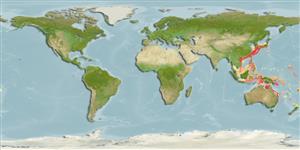Environment: milieu / climate zone / depth range / distribution range
Sinh thái học
Biển gần đáy; Mức độ sâu 65 - 278 m (Ref. 50734). Tropical
Western Pacific: Japan and Taiwan to New South Wales, Australia.
Bộ gần gũi / Khối lượng (Trọng lượng) / Age
Maturity: Lm ? range ? - ? cm
Max length : 19.0 cm TL con đực/không giới tính; (Ref. 9792)
Các vây lưng mềm (tổng cộng): 66-72; Tia mềm vây hậu môn: 51 - 57. Feebly pigmented snout, presence of supratemporal branch on lateral line of ocular side and medial dark pigmented spot on mandible and intermandibular area (Ref. 37532); lateral line on blind side absent; gill rakers on ocular side 3-6 + 7-13; caudal vertebrae 27-28; lateral-line scales on the ocular side 59-68; D 68-73, A 52-57, pectoral-fin rays on ocular side 8-10; caudal-fin rays 16-17; large ocelli on ocular side; pectoral-fin plain black or pale with black spots (Ref. 122002).
Found in the sublittoral zone on sandy mud bottoms (Ref. 11230). Rare. Feeds on small benthic animals.
Life cycle and mating behavior
Chín muồi sinh dục | Sự tái sinh sản | Đẻ trứng | Các trứng | Sự sinh sản | Ấu trùng
Hensley, D.A., 1997. Pleuronectidae. Righteye flounders. In K.E. Carpenter and V. Niem (eds.) FAO Identification Guide for Fishery Purposes. The Western Central Pacific. (Ref. 9792)
IUCN Red List Status (Ref. 130435)
Threat to humans
Harmless
Human uses
Các nghề cá: không ích lợi (thú vị)
Thêm thông tin
Các tài liệu tham khảoNuôi trồng thủy sảnTổng quan nuôi trồng thủy sảnCác giốngDi truyềnElectrophoresesDi sảnCác bệnhChế biếnNutrientsMass conversion
Các công cụ
Special reports
Download XML
Các nguồn internet
Estimates based on models
Preferred temperature (Ref.
123201): 11.1 - 26.4, mean 19.2 °C (based on 172 cells).
Phylogenetic diversity index (Ref.
82804): PD
50 = 0.6250 [Uniqueness, from 0.5 = low to 2.0 = high].
Bayesian length-weight: a=0.01622 (0.00604 - 0.04358), b=2.94 (2.71 - 3.17), in cm total length, based on LWR estimates for this (Sub)family-body shape (Ref.
93245).
Mức dinh dưỡng (Ref.
69278): 3.5 ±0.37 se; based on food items.
Fishing Vulnerability (Ref.
59153): Low vulnerability (10 of 100).
